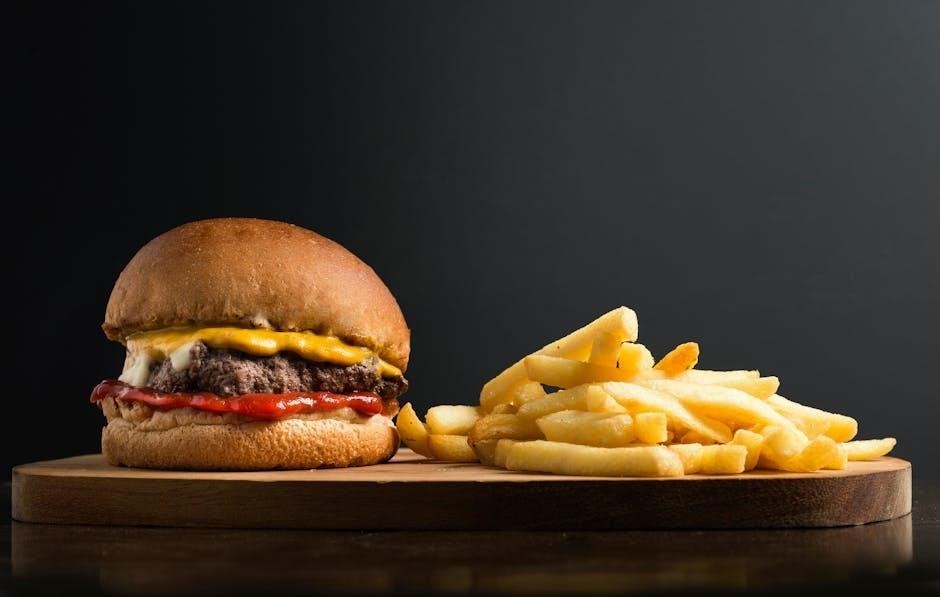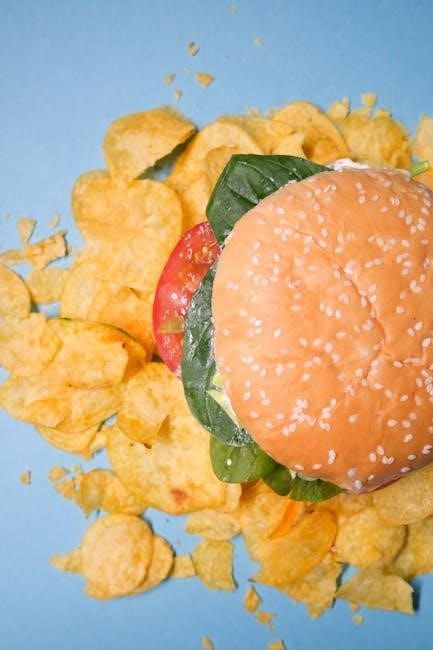A calorie deficit meal plan is a strategic approach to weight loss, focusing on consuming fewer calories than the body burns․ It emphasizes balanced nutrition, portion control, and meal variety to support a sustainable calorie deficit․ By planning and prepping meals, individuals can maintain energy levels while promoting fat loss․ This method is particularly effective for those seeking a structured yet flexible way to manage their dietary habits and achieve long-term weight management goals․
1․1 What is a Calorie Deficit?
A calorie deficit occurs when the body burns more calories than it consumes, resulting in weight loss․ It is achieved by eating fewer calories, increasing physical activity, or a combination of both․ This concept is fundamental to weight management, as it forces the body to use stored fat for energy․ A calorie deficit meal plan ensures a structured approach to creating this energy imbalance, helping individuals achieve their weight loss goals sustainably without extreme restrictions․ It is a scientifically-backed method for effective and healthy weight reduction․
1․2 Benefits of a Calorie Deficit Meal Plan
A calorie deficit meal plan offers numerous benefits, including steady weight loss, improved metabolic health, and enhanced energy levels․ It promotes fat loss while preserving muscle mass, helping individuals achieve a leaner physique․ By focusing on nutrient-dense foods, it ensures proper nutrition and reduces hunger, making it easier to stick to the plan․ Additionally, a structured meal plan fosters discipline and consistency, which are key to long-term weight management․ This approach is both effective and sustainable for those aiming to lose weight and maintain overall well-being․
1․3 Importance of Meal Planning for Weight Loss
Meal planning is crucial for successful weight loss as it ensures consistency and accountability․ By organizing meals in advance, individuals can avoid impulsive food choices and stick to their calorie deficit goals․ Proper planning also helps in managing portion sizes, balancing macronutrients, and incorporating a variety of nutrient-dense foods․ This structured approach reduces the likelihood of overeating and keeps metabolism on track․ Effective meal planning not only supports weight loss but also fosters healthier eating habits, making it a cornerstone of any successful weight management strategy․

Understanding Calorie Deficit
A calorie deficit occurs when you consume fewer calories than your body burns, leading to weight loss․ It’s a fundamental concept in weight management, achieved through diet, exercise, or both․ Understanding how to create and maintain a calorie deficit is key to effective weight loss, as it ensures your body uses stored fat for energy․ This section explores the science behind calorie deficits and how they work in conjunction with meal planning for sustainable results․
2․1 How Calorie Deficit Aids in Weight Loss
A calorie deficit occurs when your body burns more calories than it consumes, forcing it to use stored fat for energy․ This process leads to weight loss over time․ The deficit creates a metabolic environment where fat reserves are mobilized to meet energy demands․ By consistently maintaining a calorie deficit, individuals can shed excess pounds while preserving muscle mass․ The rate of weight loss varies based on factors like metabolism, activity levels, and genetics, but a steady calorie deficit remains a cornerstone of effective weight management․
2․2 Calculating Your Daily Caloric Needs
Calculating daily caloric needs is essential for creating an effective calorie deficit meal plan․ Your Basal Metabolic Rate (BMR) determines how many calories your body needs to function at rest․ Factors like age, gender, weight, height, and activity level influence this calculation․ Using online calorie calculators or consulting a dietitian can provide a personalized estimate․ For weight loss, subtract 500-750 calories from your maintenance level to create a deficit․ Accurate calculation ensures a balanced plan that supports fat loss while maintaining energy levels and overall health․
2․3 The Role of Macronutrients in a Calorie Deficit Diet
Macronutrients—proteins, carbohydrates, and fats—are crucial in a calorie deficit diet․ Proteins maintain muscle mass and satiety, while carbohydrates provide energy, and fats support hormone function․ Balancing these nutrients ensures sustained weight loss and overall health․ A typical plan includes 25-30% of calories from protein, 40-50% from carbs, and 25-30% from fats․ This balance prevents muscle loss and maintains metabolism, making the diet sustainable and effective for long-term weight management without compromising nutritional needs․ Proper macronutrient distribution is key to a successful calorie deficit strategy․

Daily Calorie Intake Levels
Daily calorie intake levels vary based on individual goals and needs, such as weight loss, maintenance, or muscle gain․ Plans range from 1000 to 2000 calories, tailored to create a sustainable calorie deficit while ensuring balanced nutrition․ Each level offers structured meal ideas to support fat loss and overall health, providing flexibility for different lifestyles and dietary preferences․
3․1 1000-Calorie Meal Plan
A 1000-calorie meal plan is designed for those seeking significant weight loss through a calorie deficit․ It includes nutrient-dense foods like lean proteins, whole grains, and vegetables, ensuring balanced nutrition․ Breakfast options might feature overnight oats with fruit, while lunches could include salads with grilled chicken․ Dinners are often light, such as steamed fish with low-carb sides․ Snacks like yogurt or nuts keep energy levels steady․ This plan is ideal for short-term use under professional guidance to avoid nutrient deficiencies and maintain metabolism health․ Portion control and meal variety are key to success․
3․2 1200-Calorie Meal Plan
A 1200-calorie meal plan is a popular choice for weight loss, offering a moderate calorie deficit while maintaining essential nutrients․ It balances proteins, carbs, and fats to keep energy levels steady․ Breakfast might include oatmeal with fruit, while lunches feature salads with lean meats․ Dinners often consist of grilled fish or chicken with steamed vegetables․ Snacks like fruits or yogurt are included to prevent hunger․ This plan is ideal for moderately active individuals and can be tailored to suit specific dietary preferences or restrictions, ensuring long-term sustainability․
3․3 1500-Calorie Meal Plan
A 1500-calorie meal plan is tailored for individuals seeking a calorie deficit without extreme restriction․ It includes nutrient-dense foods like lean proteins, whole grains, and vegetables․ Breakfast options might feature egg whites with whole-grain toast and berries․ Lunches could include grilled chicken salads, while dinners focus on fish or tofu with quinoa and steamed greens․ Snacks like nuts or Greek yogurt are incorporated to maintain satisfaction․ This plan is suitable for those with higher activity levels or requiring more energy, ensuring a balanced and sustainable approach to weight loss․
3․4 1600-Calorie Meal Plan
A 1600-calorie meal plan is designed for individuals who require a moderate calorie intake while still achieving a calorie deficit․ It includes balanced meals such as bran flakes with milk for breakfast, lean ham slices with whole-grain bread for lunch, and grilled fish with quinoa and steamed vegetables for dinner․ This plan is suitable for moderately active individuals or those who need slightly more energy․ It emphasizes portion control and nutrient-dense foods to ensure satisfaction and sustainability, making it an effective choice for steady weight loss․
3․5 2000-Calorie Meal Plan

A 2000-calorie meal plan is tailored for individuals with higher energy needs while still promoting a calorie deficit․ It features meals like oatmeal with nuts and berries for breakfast, grilled chicken with whole grains and vegetables for lunch, and baked fish with quinoa and steamed greens for dinner․ This plan is ideal for highly active individuals or those who require more calories to sustain their daily activities․ It balances macronutrients and focuses on nutrient-dense foods to support weight loss while maintaining energy levels and overall health․

Creating a Personalized Calorie Deficit Meal Plan
Creating a personalized calorie deficit meal plan involves assessing your dietary needs, balancing macronutrients, and utilizing downloadable PDF templates for structured and sustainable weight loss․
4․1 Assessing Your Dietary Needs
Assessing your dietary needs is crucial for a successful calorie deficit meal plan․ Consider factors like age, weight, height, activity level, and health goals․ Calculate your daily caloric requirements and determine the ideal deficit for weight loss․ Evaluate your eating habits, food preferences, and any dietary restrictions․ This assessment ensures the meal plan is tailored to your lifestyle and nutritional requirements, promoting sustainable and effective weight loss․ Use online tools or consult a dietitian to accurately measure your needs and create a personalized plan․
4․2 Balancing Macronutrients for Optimal Results
Balancing macronutrients is essential for a calorie deficit meal plan․ Aim for a mix of protein, carbohydrates, and fats to support energy, muscle retention, and overall health․ Protein helps maintain muscle mass, while carbohydrates provide energy, and fats support hormone production․ A typical ratio might be 25-30% protein, 40-50% carbs, and 25-30% fats․ Tailor this balance based on individual needs, activity levels, and dietary preferences․ Incorporating diverse food sources ensures nutritional completeness, making the calorie deficit more sustainable and effective for weight loss․
4․3 Downloadable PDF Templates for Meal Planning
Downloadable PDF templates simplify calorie deficit meal planning by providing structured guides․ These templates often include daily meal schedules, portion sizes, and nutritional breakdowns․ Many PDFs cater to specific calorie needs, such as 1000, 1200, or 2000 calories per day․ They also offer space for tracking progress, ensuring meals align with weight loss goals․ Popular templates include sample meal ideas, grocery lists, and macronutrient balances․ Users can print or digitally customize these plans, making meal prep efficient and organized․ This tool helps maintain consistency and accountability in achieving a calorie deficit․

Common Mistakes to Avoid
Common mistakes include neglecting protein intake, over-restricting carbohydrates, and skipping meals, which can hinder progress and lead to nutrient deficiencies․ Proper tracking and hydration are essential․
5․1 Ignoring Nutrient Density
Ignoring nutrient density is a common mistake in calorie-deficit meal plans․ While reducing calories is essential, prioritizing nutrient-dense foods ensures the body receives vital vitamins, minerals, and fiber․ Skipping fruits, vegetables, and lean proteins can lead to deficiencies and fatigue․ A balanced diet with whole grains, lean meats, and healthy fats supports overall health․ Over-relying on processed foods, even if low-calorie, can deprive the body of essential nutrients․ Always focus on quality over quantity to maintain energy levels and promote sustainable weight loss․
5;2 Overly Restrictive Dieting
Overly restrictive dieting is a common pitfall in calorie-deficit meal plans․ Severely limiting calories or eliminating entire food groups can lead to nutrient deficiencies, fatigue, and a higher likelihood of overeating․ While creating a calorie deficit is essential for weight loss, extreme restriction can slow metabolism and reduce compliance․ A balanced approach that includes variety and moderation is more sustainable․ Focus on whole, nutrient-dense foods rather than overly restrictive rules to maintain energy levels and overall health while achieving weight-loss goals․

5․3 Lack of Meal Variety
Lack of meal variety is a common mistake in calorie-deficit plans, leading to boredom and nutrient deficiencies․ Eating the same foods repeatedly can cause dissatisfaction and increase the likelihood of abandoning the plan․ Incorporating diverse protein sources, fruits, vegetables, and whole grains ensures a balanced intake of vitamins and minerals․ A monotonous diet may also slow metabolism due to repetitive calorie sources․ Prioritizing variety keeps meals engaging and supports long-term adherence to the calorie-deficit meal plan․

Meal Prep and Planning Tips

Effective meal prep involves planning balanced meals, portioning food, and using containers for organization․ This ensures consistency and reduces the likelihood of unhealthy choices, supporting weight loss goals․
6․1 Weekly Meal Planning Strategies
Weekly meal planning is essential for maintaining a calorie deficit․ Start by listing your dietary goals and preferences․ Plan breakfast, lunch, dinner, and snacks for each day, ensuring variety and nutrient balance․ Consider your schedule to prep meals in advance, saving time and reducing food waste․ Use a calorie deficit meal plan PDF for structured templates that outline portion sizes and macronutrient breakdowns․ This approach helps stay organized and committed to your weight loss journey, making healthy eating more manageable and sustainable over time․
6․2 Healthy Food Choices for Meal Prep
Focus on fresh, nutrient-dense foods like vegetables, lean proteins, and whole grains․ Incorporate fruits for natural sweetness and fiber․ Opt for lean meats, fish, eggs, tofu, or legumes as protein sources․ Whole grains like quinoa, brown rice, and oats provide sustained energy․ Healthy fats from avocados, nuts, and seeds support satiety․ Use herbs and spices for flavor instead of oils to keep calories low․ Meal prep in portions to maintain calorie deficit goals․ Prioritize variety to avoid boredom and ensure a balanced intake of vitamins and minerals․
6․4 Maintaining Portion Control
Portion control is crucial for staying within your calorie deficit goals․ Use smaller plates and measuring tools to gauge serving sizes accurately․ Avoid eating straight from packages to prevent overconsumption․ Pre-portion snacks and meals to eliminate temptation․ Pay attention to food labels for serving sizes and adjust accordingly․ Balancing macronutrients while controlling portions ensures you meet nutritional needs without exceeding calorie limits․ This practice helps maintain consistency and prevents unintended overeating, keeping your weight loss progress on track․
6․5 Staying Consistent with Your Plan
Consistency is key to achieving and maintaining a calorie deficit․ Stick to your meal plan daily, even on weekends and holidays, to avoid setbacks․ Regularly track your progress to ensure you’re meeting your calorie goals․ Adjust your plan as needed to keep things interesting and prevent boredom․ Over time, healthy habits will become second nature, making it easier to sustain your weight loss journey․ Remember, long-term success requires dedication and perseverance in following your calorie deficit meal plan․

Sample Meal Ideas
This section provides delicious and nutritious meal ideas tailored to support a calorie deficit․ Explore breakfast, lunch, dinner, and snack options that are both flavorful and healthy․
7․1 Breakfast Options
Start your day with nutrient-rich breakfasts that support your calorie deficit goals․ Options like overnight oats with fruit and nuts or scrambled eggs with spinach provide balanced nutrition․ Greek yogurt with berries and a sprinkle of chia seeds is another healthy choice․ For a hearty option, try whole-grain toast with avocado and a poached egg․ Smoothies made with protein powder, frozen veggies, and low-fat milk are also excellent․ These meals are designed to keep you full and energized while staying within your daily calorie targets․
7․2 Lunch Ideas
Lunch is a crucial meal for maintaining energy and focus․ Opt for nutrient-dense options like grilled chicken salad with mixed greens, cherry tomatoes, and a light vinaigrette․ Whole-grain wraps with lean turkey, avocado, and veggies are another satisfying choice․ Quinoa bowls with roasted vegetables and a drizzle of olive oil provide balanced macronutrients․ Lentil soup or a hearty vegetable stir-fry with tofu can also be delicious and filling․ Pair meals with a side of fresh fruit or a small portion of nuts for added fiber and flavor․ Portion control is key to staying within your calorie deficit while keeping meals satisfying and nutritious․
7․3 Dinner Recipes
Dinner is a great way to round off your day with a satisfying, nutrient-rich meal․ Grilled chicken breast with roasted vegetables like broccoli and sweet potatoes is a classic choice, offering lean protein and fiber․ Baked salmon with quinoa and steamed asparagus provides omega-3 fatty acids and complex carbs․ For a low-carb option, try turkey meatballs with zucchini noodles and marinara sauce․ These meals are balanced, flavorful, and designed to support your calorie deficit while keeping you full and satisfied․
7․4 Healthy Snack Choices
Snacks are essential for keeping energy levels steady while adhering to a calorie deficit․ Opt for nutrient-dense options like fresh fruits, raw vegetables, or a handful of nuts․ Greek yogurt with berries provides protein and fiber, while hard-boiled eggs offer a satisfying, low-calorie protein boost․ Baby carrots with hummus or a small portion of almonds are also excellent choices․ These snacks support weight loss by curbing hunger without exceeding daily calorie goals, ensuring you stay on track with your meal plan․ Portion control is key to maintaining a healthy balance․
A calorie deficit meal plan is a proven strategy for sustainable weight loss, emphasizing consistency and balanced nutrition to achieve long-term success․
8․1 The Importance of Consistency
Consistency is key to achieving and maintaining weight loss through a calorie deficit meal plan․ Regularly adhering to your daily caloric goals ensures a steady fat loss․ Skipping meals or deviating from your plan can disrupt progress, making it harder to reach your weight loss objectives․ By staying committed to your meal plan and maintaining a balanced diet, you can effectively manage your weight and improve overall health․ Consistency also helps build sustainable habits, promoting long-term success․
8․2 Final Thoughts on Calorie Deficit Meal Plans
A calorie deficit meal plan is a proven strategy for weight loss, offering a structured approach to achieving your goals․ By focusing on nutrient-dense foods and portion control, you can sustain a healthy deficit without feeling deprived․ Printable PDF guides provide practical support, helping you stay organized and motivated․ Remember, consistency is crucial for success․ With dedication and the right plan, you can maintain a calorie deficit effectively, leading to lasting weight loss and improved overall health․
